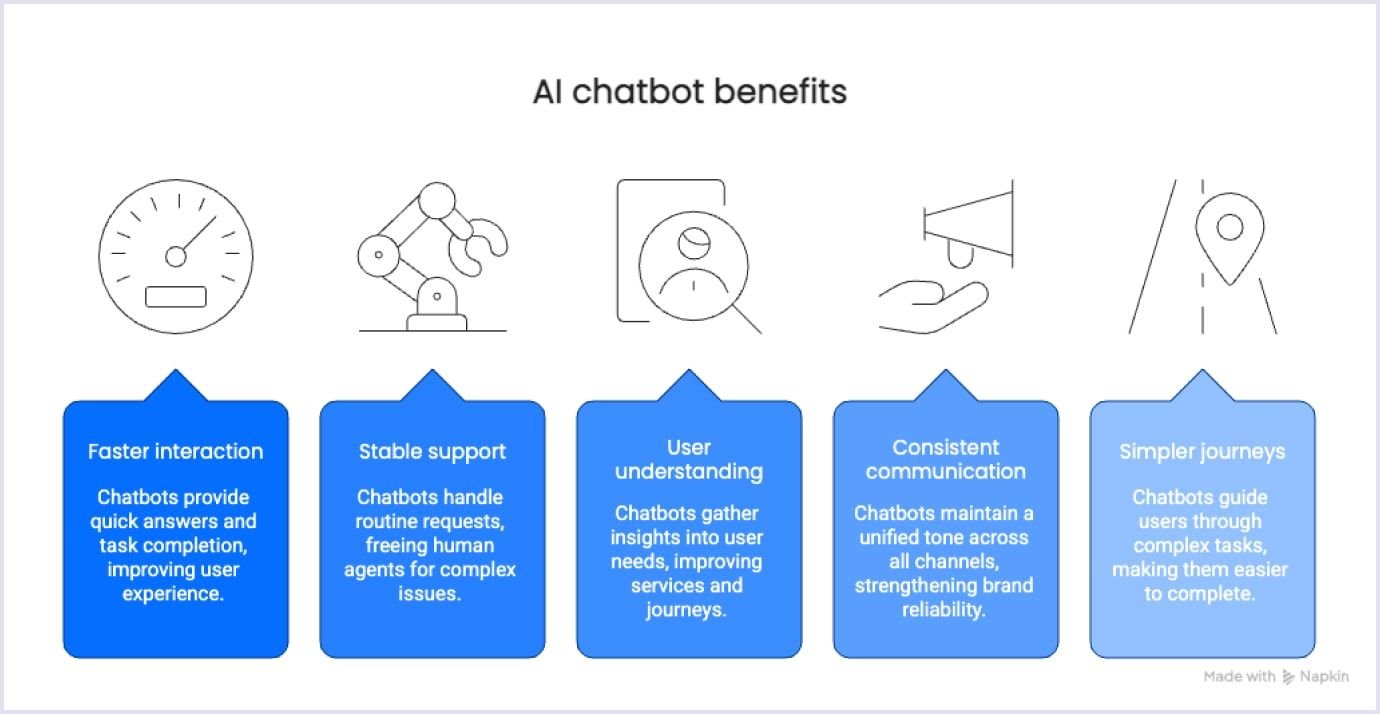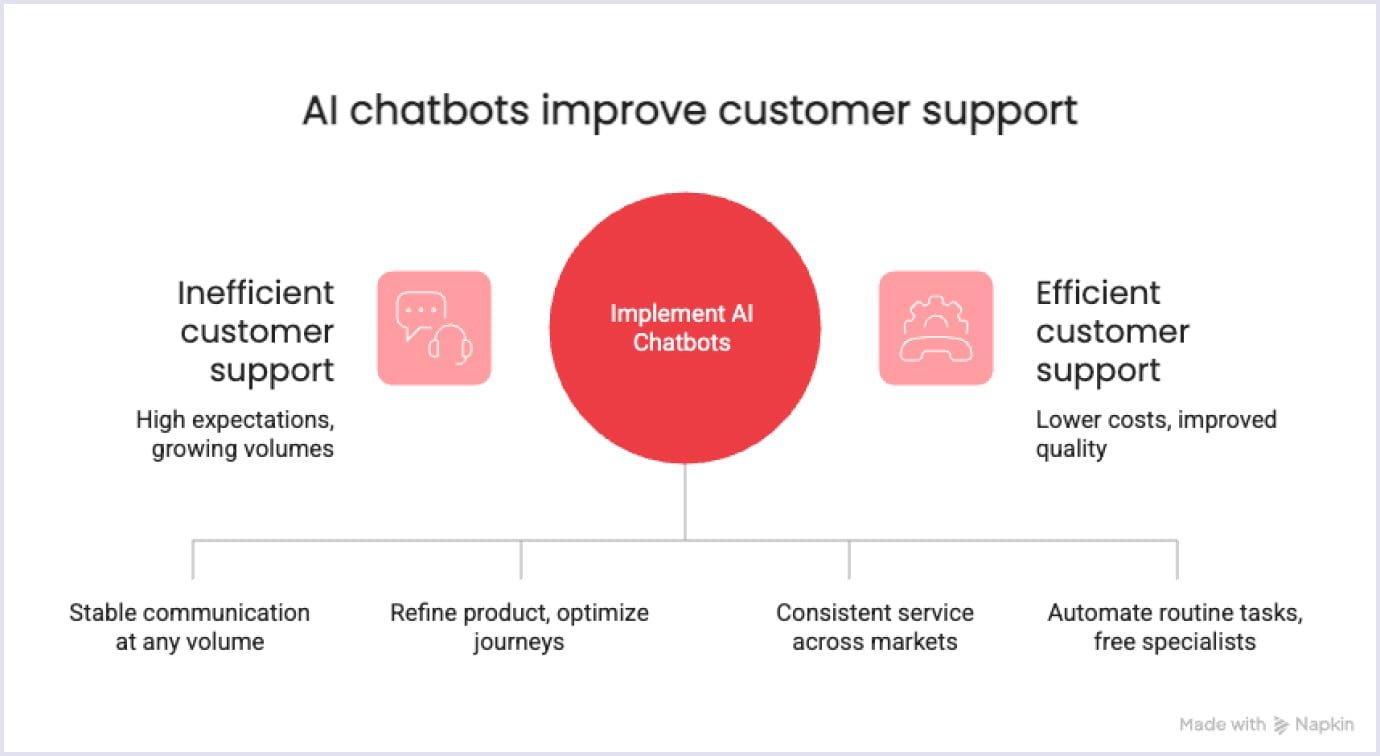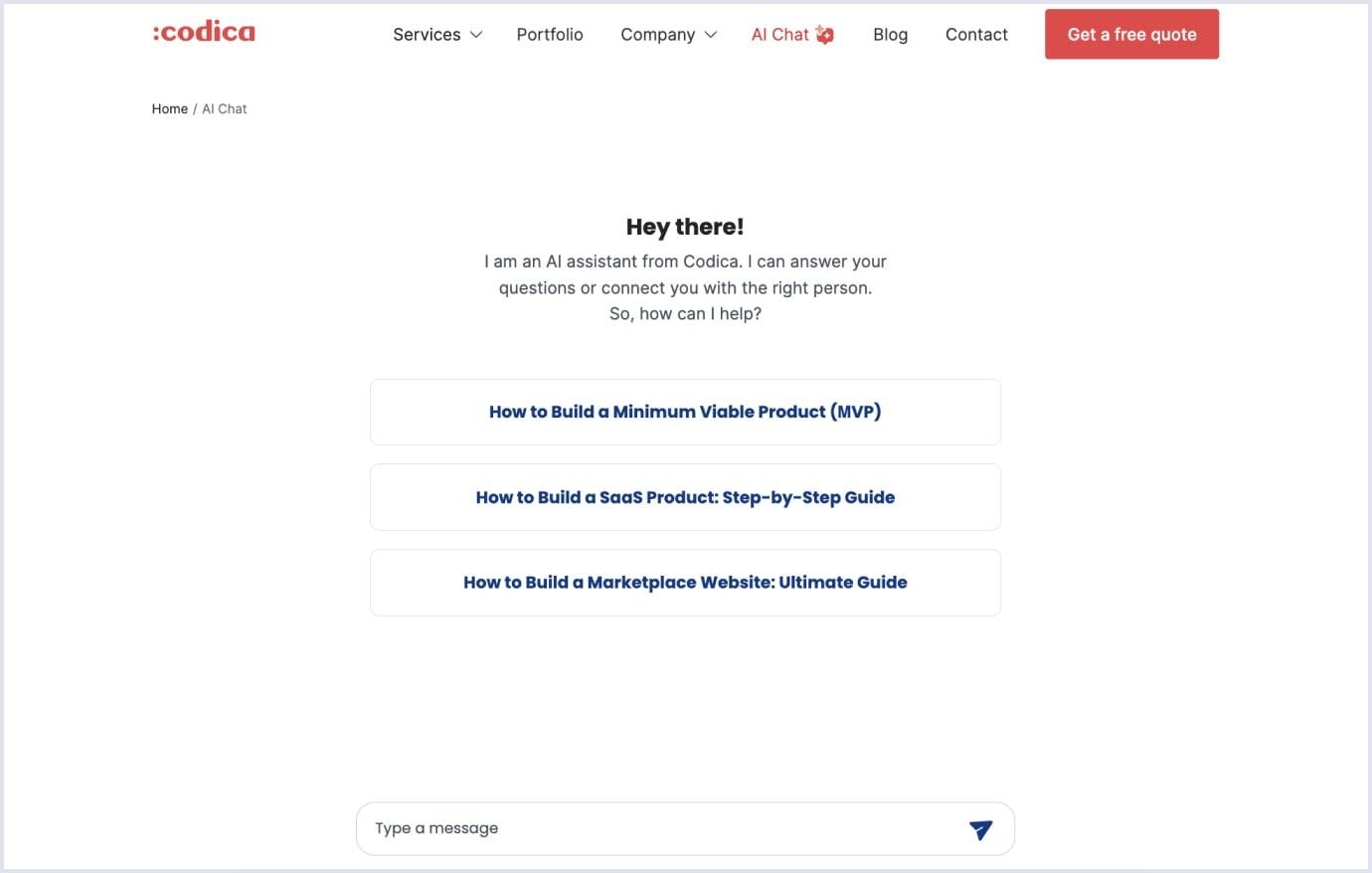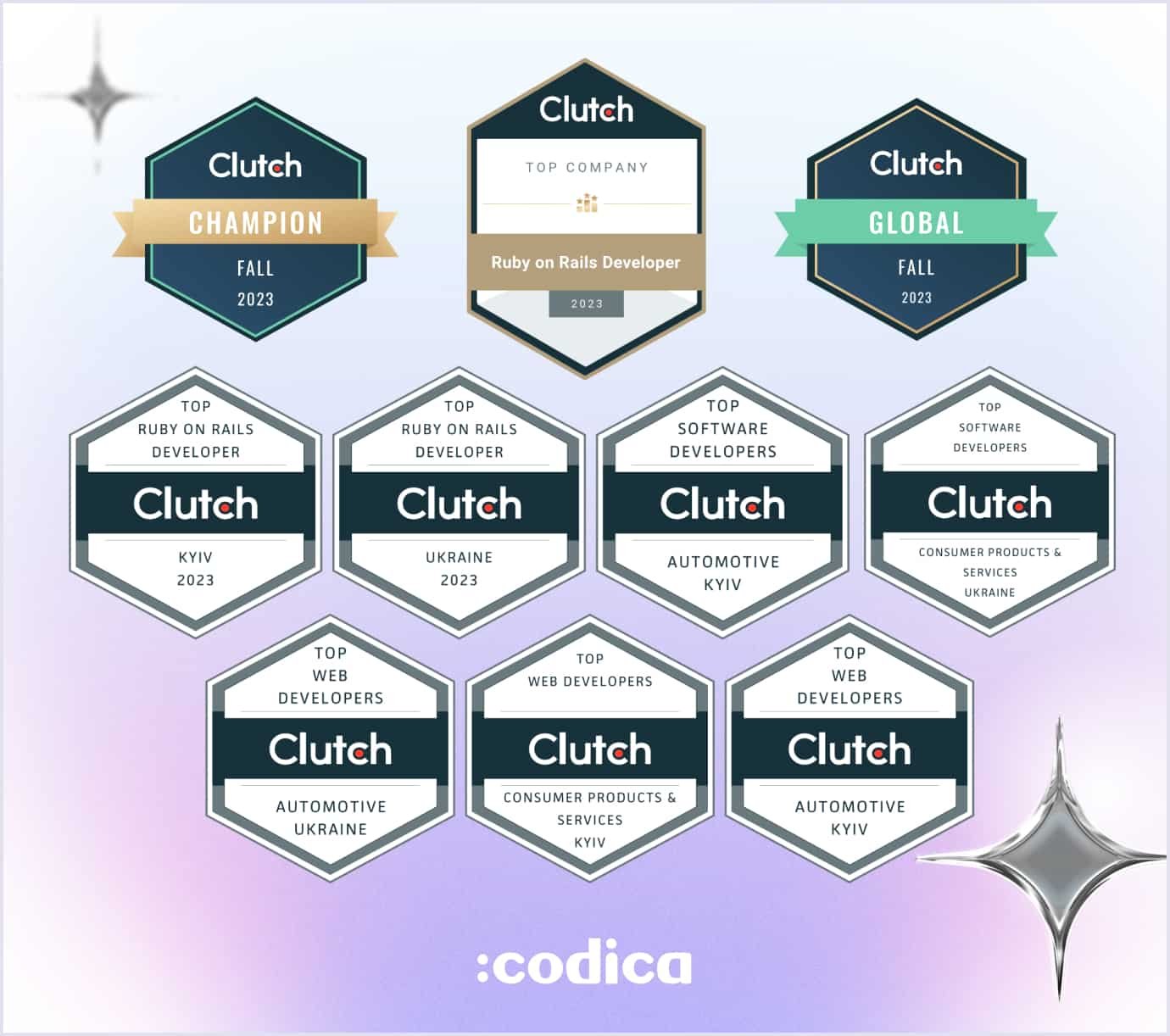Every day, people open apps, visit websites, and expect instant clarity. No searching. No waiting. No instructions.
Behind this seamless experience usually stands a silent helper, the system that answers questions, guides users, and keeps interaction moving without interruptions. Most customers never notice it, but they rely on it constantly. This helper is your chatbot.
The shift in digital behavior has made on-demand communication a core requirement for modern products. That’s why companies invest in AI chatbot development.
Not for novelty, but to match the way customers want to interact today. And when you decide to build an AI chatbot, you’re not just adding a feature. You’re shaping how your business communicates, supports, and educates its users.
In this guide, we explore how to create a chatbot from scratch that users trust, your team benefits from, and your entire digital ecosystem can grow with. And if you prefer a reliable partner to handle the process end-to-end, Codica can design, build, and integrate a custom chatbot tailored to your product and operational needs.
Why building an AI chatbot matters in today’s world
Digital communication today requires speed, clarity, and consistency. Users expect simple interaction without long searches or delays, and this makes AI chatbot development a practical necessity for modern digital products.

Faster interaction where it matters
A custom chatbot helps users get information, complete a task, or resolve a question within seconds. Clear prompts and guided steps reduce friction and improve the overall experience across websites, apps, and messaging platforms.
Stable support as your business grows
Routine communication increases with business growth. When a company decides to build an AI chatbot, it gains a tool that keeps support predictable and organized. The chatbot handles recurring requests, freeing specialists to focus on tasks that require human attention.
Better understanding of user needs
A conversational chatbot collects valuable insights during everyday interactions: common issues, preferences, intent, and content gaps. This helps businesses refine services and improve user journeys without additional research overhead.
Consistent communication across channels
Through proper chatbot integration, companies maintain the same tone and logic across all touchpoints: website, mobile app, social media, or messenger. This consistency strengthens the user experience and supports brand reliability.
Simpler user journeys
Many digital tasks involve multiple steps that confuse users. A chatbot for business guides them through each stage in a natural, easy-to-follow form, helping complete actions without frustration.
How AI chatbots improve customer support and service efficiency
Customer service today operates under constant pressure: high expectations, growing volumes, and the need for consistent communication across multiple channels.
This makes AI chatbots a practical tool for companies that want to improve support quality without increasing operational load.

Scalability where it matters
A chatbot keeps customer communication stable at any volume. It handles recurring questions, guides users through typical actions, and responds instantly, even during peak hours. This helps businesses maintain predictable service without expanding the support team unnecessarily.
Clear insights from every interaction
Modern chatbots naturally collect structured information: common issues, user intent, preferences, and points of confusion. These insights help companies refine their product, plan updates, and optimize customer journeys without separate research or additional tools.
Support for a global audience
With built-in language understanding, chatbots can communicate across markets and adapt to regional specifics. This allows international companies to offer consistent service and makes digital products accessible to users who prefer interacting in their native language.
Reduced operational overhead
By automating routine tasks, from FAQs to booking flows and order checks, a chatbot frees specialists for work that requires human involvement. The result is simple: fewer repetitive interactions, fewer delays, and lower service costs without compromising quality.

AI-powered chatbots vs. basic chatbots
By 2026, the distinction between chatbot types is no longer about “smart vs. simple.”
Instead, businesses choose between two architectural approaches: rule-based chatbots and LLM-powered chatbots.
Each supports a different layer of customer interaction, and the right choice depends on what your service actually needs.
Rule-based chatbots
These chatbots operate on predefined flows and logic trees.
Best suited for:
- predictable, structured user interactions;
- step-by-step processes like booking or FAQs;
- scenarios requiring strict consistency.
Strengths:
- controlled, reliable responses;
- easy to maintain;
- low operational complexity.
Limitations:
- cannot process free-form questions;
- limited intent recognition;
- require manual updates for every new scenario.
They remain relevant for tasks where stability matters more than flexibility.
AI-powered (LLM-based) chatbots
These chatbots rely on large language models to interpret meaning, understand context, and respond naturally, a core component of modern AI chatbot development.
Best suited for:
- unstructured queries;
- high-volume support;
- troubleshooting, onboarding, and recommendations.
Strengths:
- understands natural language inputs;
- handles broad conversation patterns;
- reduces the need for extensive manual scripting.
Limitations:
- requires proper configuration and testing;
- depends on data sources for accuracy;
- higher governance and infrastructure demands.
LLM-based chatbots are now the standard for products that aim to deliver human-like communication.
The 2026 reality: Hybrid chatbots
Most effective custom chatbot solutions combine both approaches. AI handles intent recognition and natural conversations, while rule-based modules execute structured tasks such as payments, verification, or policy-bound responses. This hybrid architecture offers the best balance of flexibility and reliability.
Building your custom AI chatbot: Step-by-step
Creating a chatbot is a structured product process that connects strategy, communication design, development, and ongoing refinement.
Each stage adds a specific layer of clarity and stability, resulting in a solution that supports users and fits your operational environment.
The steps below reflect how mature teams, including Codica’s approach to chatbot projects, end-to-end.

Step 1. Define the chatbot’s purpose and scope
Every chatbot begins with a clear understanding of what it should accomplish. This stage aligns business goals, user needs, and technical limitations. Work here often mirrors what companies complete during product discovery services, where the foundation of the future solution is formed.
Key elements to determine:
- the primary tasks the chatbot should handle;
- typical scenarios it must support;
- channels where it will operate;
- responsibilities, boundaries, and escalation rules.
A precise scope ensures that the chatbot is developed for specific outcomes rather than assumptions.
Step 2. Understand user behavior and conversation patterns
A chatbot becomes effective when it reflects how users communicate and what they expect throughout the journey. This step focuses on gathering real behavioral insights.
Important areas to analyze:
- common questions and recurring tasks;
- preferred communication style and tone;
- moments where users typically need guidance;
- information that must always remain clear and accessible.
These insights guide conversational logic and help align the chatbot with real user situations instead of theoretical ones.
Step 3. Design the conversational structure
With goals and user patterns defined, the next step is to outline the structure of interactions. This creates a predictable experience that guides users from entry to resolution.
Elements to design include:
- entry points and welcome prompts;
- main conversation paths for specific tasks;
- clarification questions for incomplete inputs;
- fallback messages that keep the dialogue moving;
- handover logic for human involvement when needed.
This structure forms the backbone of the chatbot’s behavior.
Step 4. Prepare the content and initial responses
Content is the layer users interact with directly. It should be clear, concise, and aligned with your brand’s voice. This step includes writing helpful responses and organizing them into practical communication blocks.
Content preparation typically includes:
- instructions for completing tasks;
- standard answers for recurring questions;
- alternative phrasing for the same message;
- neutral, helpful fallback messages;
- prompts that guide users without confusion.
At Codica, this work is part of our ChatGPT development services, where conversation logic and content are shaped to support the product’s objectives.
Step 5. Choose the platform and technical stack
Once the conversational structure and content are ready, the technical foundation is selected. This includes choosing platforms, frameworks, language models, and integration methods. This phase falls within the scope of AI development services, where technology decisions are aligned with functionality, performance expectations, and maintenance needs.
Common deployment channels include:
- websites and web applications;
- mobile apps;
- messaging platforms;
- internal service tools.
A thoughtful selection here ensures the chatbot operates reliably and scales with your product ecosystem.
Step 6. Integrate the chatbot with internal systems
To perform meaningful tasks, a chatbot must connect with business systems and real data. This allows it to retrieve information, create requests, update records, and support operational workflows.
Integrations may include:
- CRM platforms;
- product or order databases;
- user authentication systems;
- scheduling or booking tools;
- external APIs for specific functions.
These connections transform a chatbot from a communication layer into a functional part of your product infrastructure.
Step 7. Test, validate, and refine the chatbot
Before release, the chatbot must be thoroughly tested. This ensures that conversations, integrations, and flows work as intended under different conditions. This process is handled through our quality assurance services, where stability, accuracy, and usability are validated.
Testing often includes:
- reviewing complete conversation paths;
- checking behavior across various inputs;
- confirming integration reliability;
- evaluating clarity and timing of responses;
- identifying usability issues.
After launch, the chatbot is monitored and refined based on real usage. Regular updates keep it aligned with your business operations and evolving user expectations.
Codica’s experience in AI chatbot development
At Codica, we apply a practical, system-oriented approach to building chatbots and conversational tools. Our experience includes projects where assistants guide users through structured input, generate content, and connect to multiple data sources.
One example is RecruitAgent.ai, a recruitment platform where we implemented a conversational intake assistant for creating job descriptions. The solution generates text, adjusts tone, supports multilingual output, and works with several integrations, including OpenAI and labor-market APIs. This helped automate tasks that previously required hours of manual work.

We also built Codica’s internal AI assistant, which retrieves information from our services, case studies, and blog content. It uses structured prompts, vector search, and context management to deliver accurate answers and help users navigate complex information quickly.

Across these projects, our team worked on conversation design, prompt logic, integrations, scalable architecture, and quality assurance: core elements needed to build a chatbot that stays reliable in real product environments.

Building what your users actually need
Creating a chatbot from scratch involves many moving parts: discovery, conversation design, integrations, and continuous refinement. But when these elements come together, the result is a tool that saves time, improves service, and enhances the user experience across channels.
You can review similar solutions in our portfolio.
If you're considering developing your own chatbot, feel free to contact us - we’ll guide you through each step.
